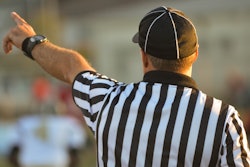
The NFL's competition committee, as well as its health and safety committee, are mulling penalizing the hip-drop tackle, which the league says results in an injury rate 25 times that of a typical tackle.
While the league calls the tackle, a hip-drop tackle, there still some ambiguity as to what that actually means.
“It is an unforgiving behavior, and one that we need to try to define and get out of the game,” Miller said.
NFL competition committee chair Rich McKay told Yahoo Sports the hip-drop is a "cousin" to the horse-collar tackle, which consists of grabbing the collar of the back side of an opponent's shoulder pads or jersey to a pull a runner toward the ground. A hip-drop tackle similarly involves a tackler grabbing a ball carrier from behind and pulling him down in a manner that prevents self-defense.
“The defender’s encircling, tackling the runner, and then swinging their weight and falling on the side of their other leg, which is their ankle or their knee,” McKay said. “You can see what they do, because it can be a smaller man against a bigger man, and they’re trying to get the person down. That’s the object of the game. But when they do it, the runner becomes defenseless.”
Patrick Mahomes has been limping after having a Jaguars player land on his ankle. He has stayed in the game…pic.twitter.com/zAmQfzLSBy
— Doug Rush (@TheDougRush) January 21, 2023
Cowboys executive vice president Stephen Jones echoed McKay's comments.
“They grab them around the hip and sling their body around and land on the back of their legs,” Jones told Yahoo Sports on Tuesday from the league meetings. “I wouldn’t say it’s intentional all the time. But unfortunately, it’s a deal kind of like the horse collar that when it happens, people get hurt. It’s a very injurious play.”
The NFL has been meeting with coaches to discuss possibilities for refereeing the hip-drop tackle, and analyses of 2023 data will continue to inform what eventually happens in the spring.
McKay acknowledges that the league will take criticism should the hip-drop be banned.
“You’re always going to have the defender come back and say, ‘Hey, you’re making it harder on us,’” McKay said. “And the answer to that is, ‘Yes, we are.’ Because when there’s a tactic that’s being used or a technique that’s creating an unreasonable risk of injury to a player, it’s our job to try to find a way to regulate that. If we can get it out, we should get it out.”





































